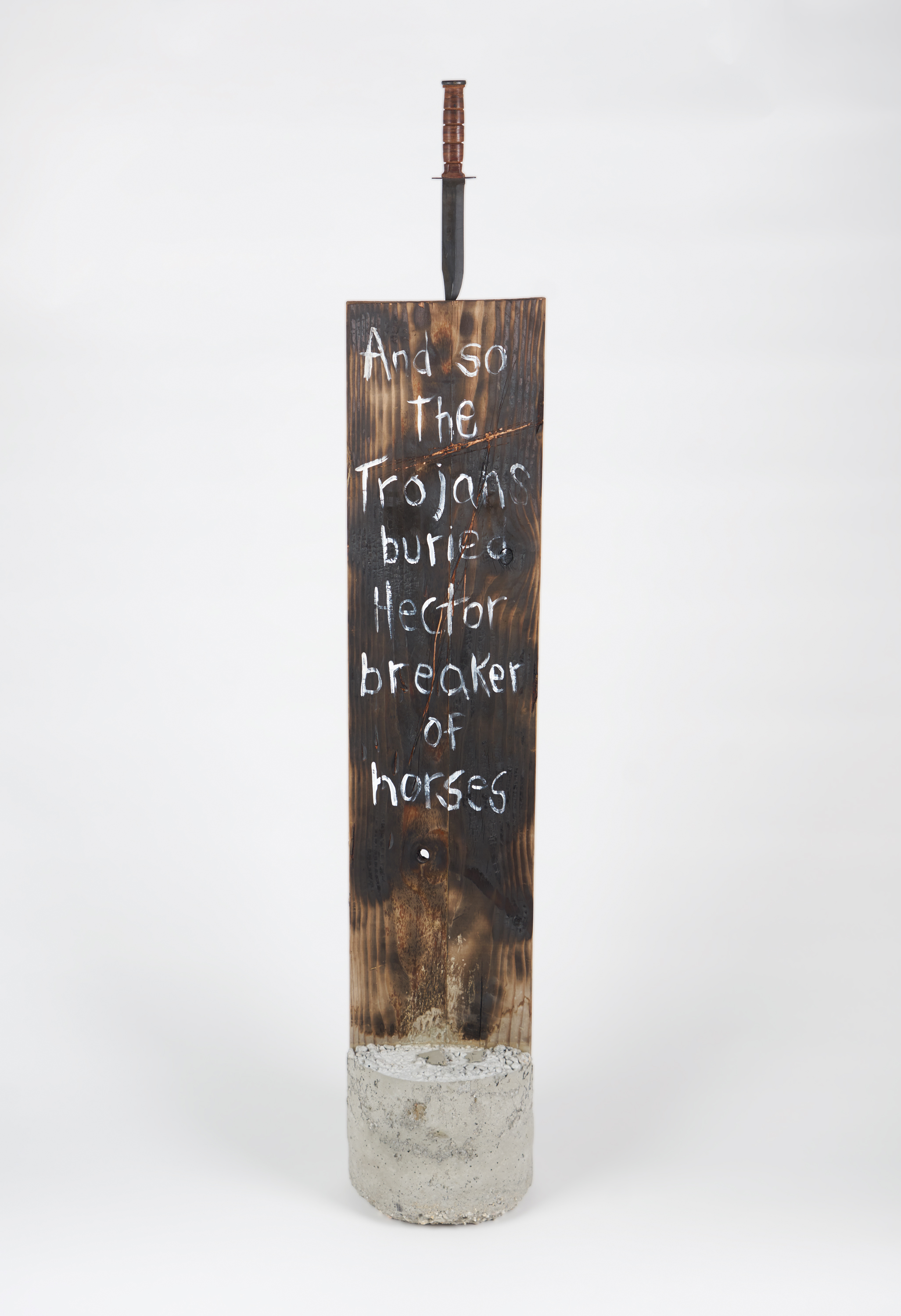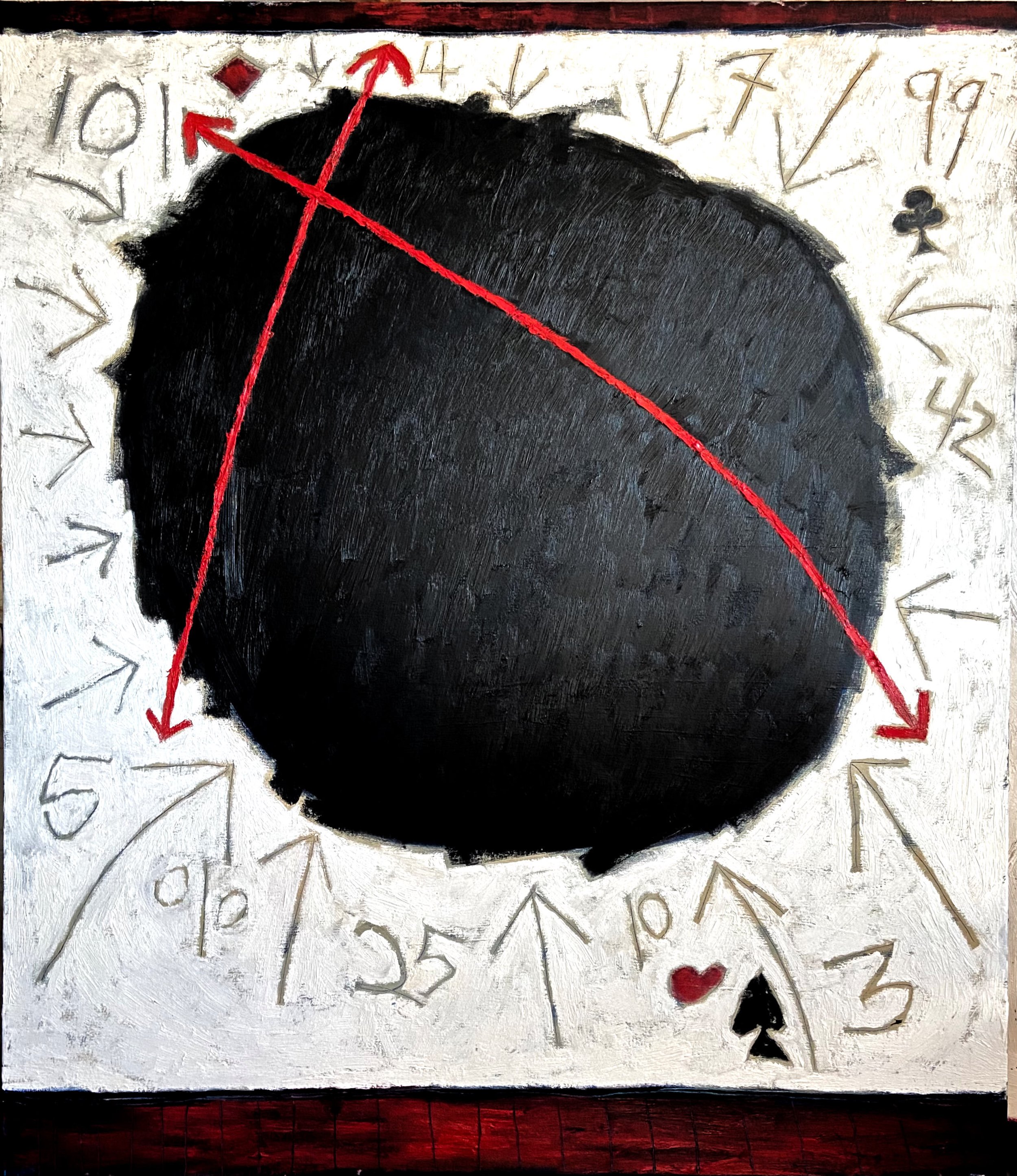Trojan War Paintings
Trojan War Paintings
“I quit admiring the problem a while back - my friends heading off to war while I was left teaching at the George Washington University, the Japanese stones, the characters from the Iliad, Itten’s book on color theory, and painting. It all got mixed up inside my head and that’s what came out. I’ve been doing these paintings for nearly twenty years.”
While serving in the USMC, David Richardson lived at the base of Mount Fuji, near Tokyo. There, he noticed the Japanese used shaped stones with Kanji inscriptions to identify residences and businesses. Exposed to the elements, the stones weather, take on a distinct character, and become part of the Japanese landscape; the images of the stones stuck with Richardson.
After returning from Japan, Richardson painted two paintings based on his reminiscence of the stone markers. As the paintings evolved, he disregarded the literal image of the stones and applied a checker board motif inscribed with binary code, mimicking the calligraphic Kanji inscriptions of the original stones.
At the same time he was exploring the stone monument theme with paint, Richardson was teaching a class on the origins of western warfare at The George Washington University. This included a close reading of the Iliad; with the epic on his mind, he began using names from Homer as titles for the stone paintings. Essentially, each piece in the series is a monument to a character in the Iliad.
The Myth of Progress
The Myth of Progress
“Folks often ask what I paint. I usually skip right to why.”
David Richardson’s paintings reinforce mythology, symbols, and Jungian archetypes as the universal blueprints we all live by. Taught to paint by his mother and brother, he reaches across art forms using a diverse range of media and subjects to express the pressure of the past and the vacuum of the future. His work exists at the fault lines of love, war, chaos, religion, celebrity, fantasy, fear, and oblivion.
In work inspired by Homer, his international deployments, and the rapidly evolving impact of technology and globalization, Richardson explores the unyielding and essential role that myth plays in our lives.
Shotgun Paintings
Shotgun Paintings
“I took risks in the war for a reason. There is no doubt, I was more fearful of failing the Marine Corps and being degraded in the eyes of fellow Marines than of being killed. For those who have served in elite units that sentiment prevails; it’s been so for thousands of years.”
During street fighting in Ramadi and Fallujah, Iraq, Richardson noted the impact of stray gunfire and its decaying effect on the city. One particular memory he has is of a plywood sign featuring the figure of a man hoisting a barbell over his head, an advertisement for a local gym. As months passed, the sign splintered to near oblivion, first the figure’s legs, then his head and arms, and finally, most of his torso disappeared as the fighting smoldered on. Nearly ten years later, Richardson began to develop his own bullet ridden and splintered war motifs.
In wartime, cards are the time killer’s friend, a way to pass time between patrols, operations, and the work of war. In Iraq, U.S. troops were issued playing card decks featuring Iraqi officials wanted by the U.S. Government. In the Shotgun Paintings, Richardson references the design of these cards with images stenciled on building material commonly used in Iraq - corrugated tin and plywood. Echoing the effect of random gunfire, Richardson used a shotgun to perforate the paintings and simulate the chaos he witnessed in combat. Through the imagery, the idea that luck is an inherent part of life, particularly evident in games of chance and warfighting is preserved.
R3 Paintings
R3 Paintings
“It was a time of great debauchery for me. I hung out with expatriates - Australians, Canadians, Brits, New Zealanders, and other Americans, most of them on an extended get-away from their home country - and drank a lot. I often left the bar in the early morning hours and glanced up to see the neon crosses in the hills above, staring down at me. Despite the bustle of the city and the friends I made, the alienation I experienced living for two years in Korea outpaced the danger I experienced in war. The crosses kept reminding me I’d eventually get to leave.”
Following a tour in Iraq, Richardson was posted to Seoul Korea for two years. There, he saw how the Koreans used large, brightly colored neon signs to mark their churches at night. Because Seoul is a city surrounded by mountains, the neon crosses topping the churches in the hills are a prominent part of the nighttime landscape; the Resurrection Series draws on this.































